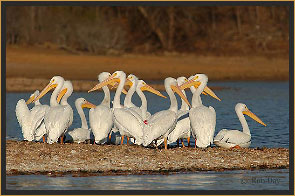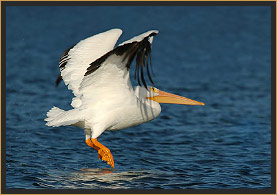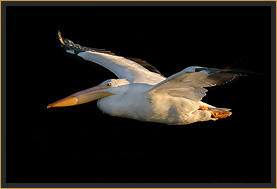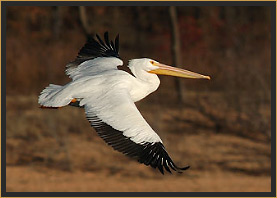|
The Pelicans of Tenkiller Ferry Text and Photography © Ron Day For the past several years, American White Pelicans, making their first appearance on Tenkiller Ferry Reservoir, have captivated the interest of residents and visitors. In autumn, during migration, these graceful birds arrive at the north end of the reservoir and join loons and gulls in a protracted feast on shad, an abundant baitfish in the lake. As many as two to three hundred pelicans eat, preen, and sun themselves on the water over a period of a few months, before departing for points south. I have extensively photographed these majestic birds, and in the process, I've developed great respect and admiration for them. Unlike its cousin the Brown Pelican, the American White Pelican inhabits fresh water lakes and rivers. About half of all White Pelicans in North America nest in the Canadian provinces of Alberta, Manitoba, and Saskatchewan. The White Pelican was removed from the national threatened species list in Canada, in 1987. In British Columbia, however, "in recent decades the number of pelicans has dropped drastically because of the use of pesticides, human disturbance, and the draining of wetlands." www.bcadventure.com.
When photographing these birds, I use a 500 mm telephoto lens with a 1.7X teleconverter, which provides a focal length of 850 mm. This magnification allows me to observe the pelicans up close, and watch in detail many of their daily activities. The wingspan of the White Pelican is 108 to 110 inches (9 feet), and their body length is 60 inches (5 feet). They weight, on average, 16.5 pounds. The way they maneuver their large bodies so gracefully through the air is simply breathtaking.
This species does not dive into the water for food like the Brown Pelican. Rather, it generally prefers to fish in more shallow water where it can scoop up to 3 gallons in its pouch, and strain out young fish, salamanders, frogs, and aquatic invertebrates. If food is not readily available, these birds are known to form a feeding line in shallow water, and "herd" prey towards the shore by slapping their wings on the surface of the water. At Tenkiller Ferry, however, most of the pelicans feed in deeper water on schools of shad driven to the surface by hungry white bass. When pelicans observe that gulls have located shad on the surface, they promptly fly over, lower their large webbed feet, and ski in to join the feast. They consume up to 3 pounds of fish a day.
As each autumn approaches, I anxiously await the arrival of the pelicans at Tenkiller Ferry. Their return signals the beginning of a new season of photographic dreams and opportunities with one of the most noble birds on earth. [ See more pelicans in the White Pelican Gallery. ]
|



